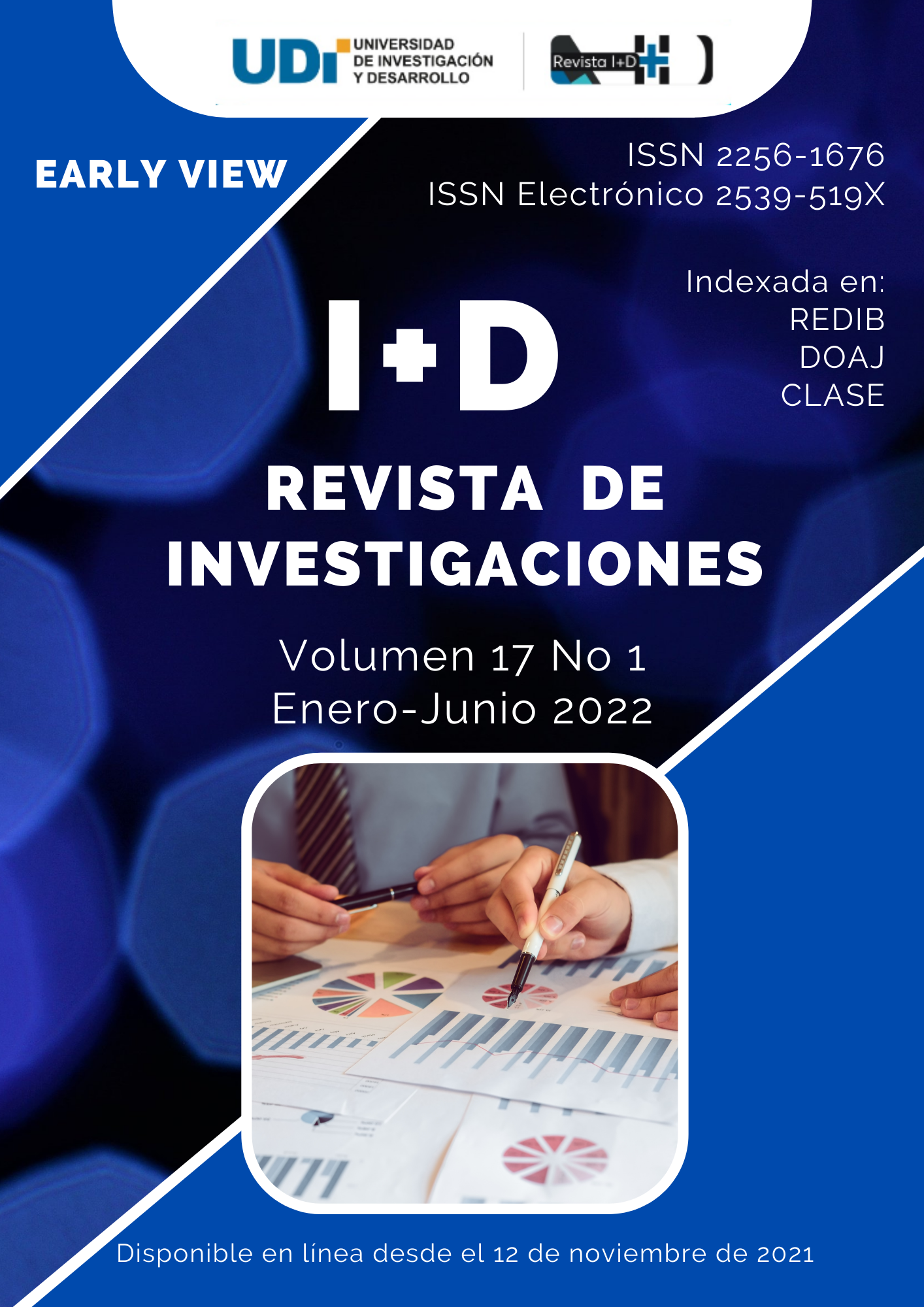Job satisfaction in gastronomic establishments of Bucaramanga, Santander
DOI:
https://doi.org/10.33304/revinv.v17n1-2022002Keywords:
Job satisfaction, gastronomic establishments, tourism sector, work conditions, BucaramangaAbstract
Job satisfaction is the result of the relationship between work and attitudes towards it; therefore, it is an element that positively or negatively affects the productivity of organizations in different economic sectors, such is the case of the gastronomic sector in the city of Bucaramanga, which is the object of research of this article, considering its relevance in the value chain of the tourism sector. In this sense, the objective is to describe the dimensions of job satisfaction inherent to the S20/23 questionnaire, namely, work, participation in decisions, relationship with superiors, physical working conditions and recognition. The methodology applied is based on a quantitative and descriptive approach, considering the application of the questionnaire to 90 workers in 30 establishments of the economic activity. The results show a marked tendency towards the possession of good physical working conditions, which could be directly associated with the practice of actions related to safety and health at work.Downloads
References
Cardona Arbelaez, D., Lamadrid Villarrreal, J., & Brito Carrillo, C. (2018). La gestión y dirección del talento humano desde el análisis sobre clima organizacional y sus dimensiones. Un estudio de caso. Aglala, 9(1), 154-176. https://doi.org/10.22519/22157360.1185
Bonillo Muñoz, D., & Nieto González, F. J. (2002). La satisfacción laboral como elemento motivador del empleado. Trabajo. Revista Iberoamericana de Relaciones Laborales, 11, 189–200. https://doi.org/10.33776/trabajo.v11i0.166
Bòria-Reverter, S., Crespi-Vallbona, M., & Mascarilla-Miró, O. (2012). Variables determinantes de la satisfacción laboral en España. Cuadernos de Economía, 35, 9–16. https://doi.org/10.1016/S0210-0266(12)70018-3
Conte, J. M., Dean, M. A., Ringenbach, K. L., Moran, S. K., & Landy, F. J. (2005). The relationship between work attitudes and job analysis ratings: Do rating scale type and task discretion matter? Human Performance, 18(1), 1–21. https://doi.org/10.1207/s15327043hup1801_1
Franco Pérez, E., Montesinos López, O. A., Magaña Echeverría, M. A., & Refugio Tene, H. (2010). Índice de satisfacción laboral . Mercados y Negocios 21: Revista de Investigación y Análisis, 11(1), 72–95. https://dialnet.unirioja.es/servlet/articulo?codigo=6149990
García-Bernal, J., Gallago-Castel, A., Marzo-Navarro, M., & Rivera-Torres, P. (2005). Job satisfaction: empirical evidence of gender differences. Women in Management Review, 20(4), 279–288. https://doi.org/10.1108/09649420510599098
Gibson, B. S. (1996). The Masking Account of Attentional Capture: A Reply to Yantis and Jonides. Journal of Experimental Psychology: Human Perception & Performance, 22(6), 1514–1520. https://doi.org/10.1037/0096-1523.22.6.1514
González, J. L., & Ruiz, P. (2011). Investigación cualitativa versus cuantitativa: ¿Dicotomía metodológica o ideológica? Index de Enfermeria, 20(3), 189–193. https://doi.org/10.4321/s1132-12962011000200011
Güell, L. (2014). Estudio de la satisfacción laboral de los maestros [Universidad Internacional de Cataluña. Ciencias Humanas, Sociales y Jurídicas]. https://www.tdx.cat/bitstream/handle/10803/293783/Tesi_Luisa_Güell_Malet.pdf?seq
Guerrero Bejarano, M. A., Parra Suárez, R. J., & Arce Vera, M. F. (2018). La Satisfacción laboral y su efecto en la satisfacción del cliente, un análisis teórico. INNOVA Research Journal, 3(8), 140–146. https://doi.org/10.33890/innova.v3.n8.2018.879
Hernández, R., Fernández, C., & Baptista, P. (2014). Metodología de la Investigación (sexta ed). McGRAW-HILL. http://observatorio.epacartagena.gov.co/wp-content/uploads/2017/08/metodologia-de-la-investigacion-sexta-edicion.compressed.pdf
Herzberg, F. (1976). One More Time: How Do You Motivate Employees? In Job Satisfaction — A Reader (ed, pp. 17–32). Palgrave Macmillan UK. https://doi.org/10.1007/978-1-349-02701-9_2
Iriarte, I., Alberdi, A., Urrutia, E., & Justel, D. (2017). Beyond customer satisfaction. Supporting organisational change through Service Design. A case study in the insurance industry. The Design Journal, 20(Sup1), S424–S434. https://doi.org/10.1080/14606925.2017.1352950
Jaimes-Dueñas, K. J., Serrano-Pérez, W. F., & García-Méndez, S. (2021). Estudio de Satisfacción Laboral entre las generaciones X y Y en Bucaramanga y su área metropolitana. I+D Revista de Investigaciones, 16(2), 35–46. https://udi.edu.co/revistainvestigaciones/index.php/ID/article/view/297/387
Lawler, E. E., & Suttle, J. L. (1973). Expectancy theory and job behavior. Organizational Behavior and Human Performance, 9(3), 482–503. https://doi.org/10.1016/0030-5073(73)90066-4
Locke, E. . (1976). La naturaleza y las causas de satisfacción en el trabajo. In Manual de psicología industrial y organizacional (ed, pp. 165–166). Rand McNally College.
Loitegui Aldaz, J. R. (1990). Determinantes de la satisfacción laboral en empleados de la administración foral de Navarra [Universidad Complutense de Madrid]. https://dialnet.unirioja.es/servlet/tesis?codigo=142004
Martín, A. L. (1981). Una aproximación sociológica al estudio de la satisfacción en el trabajo en la provincia de Santander. Reis. Revista Española de Investigaciones Sociológicas, 13, 65–100. https://doi.org/10.2307/40182835
Meliá, J. L., & Peiró, J. M. (1998). Cuestionario de Satisfacción Laboral S20/23 (pp. 1–5). Linea de Investigación de Psiclología de la Seguridad. Universidad de Valéncia. https://www.uv.es/meliajl/Research/Cuest_Satisf/S20_23.PDF
Meliá, J. L., Pradilla, J. F., Martí, N., Sancerni, M. D., Oliver, A., & Tomás, J. M. (1990). Estructura factorial, fiabilidad y validez del Cuestionario de Satisfacción S21/26: Un instrumento con formato dicotómico orientado al trabajo profesional. Revista de Psicología Universitas Terraconiensis, 12(1/2), 25–39. https://www.uv.es/meliajl/Research/Art_Satisf/ArtS21_26.PDF
Mendoza-Flórez, Y., Villamizar-Correa, P. A., García-Méndez, S., & Gutiérrez, J. C. (2021). Relación entre la cultura organizacional, la satisfacción laboral y el engagement en el sector confecciones de Piedecuesta, Santander. I+D Revista de Investigaciones, 16(1), 216–224. https://doi.org/10.33304/revinv.v16n1-2021017
Mendoza-Vega, R. F., Murillo-Murillo, E. G., & García-Méndez, S. (2020). Relación entre satisfacción laboral y engagement en empleados operativos de la empresa de transporte Cotrascal S. A. S. I+D Revista de Investigaciones, 15(1), 69–76. https://doi.org/10.33304/revinv.v15n1-2020008
Muñoz, A. (1990). Satisfacción e insatisfacción en el trabajo [Universidad Complutense de Madrid]. https://books.google.com.co/books/about/Satisfacción_e_insatisfacción_en_el_tr.html?id=t-EGGQAACAAJ&redir_esc=y
Nieto, E. (2016). Variables críticas en satisfacción laboral. ORP Journal. Fundación Internacional ORP, 6, 11–18. http://www.orpjournal.com/index.php/ORPjournal/article/view/46/84
Núñez González, E., Estévez Guerra, G. J., Hernández Marrero, P., & Marrero Medina, C. D. (2007). Una propuesta destinada a complementar el cuestionario Font-Roja de satisfacción laboral. Gaceta Sanitaria, 21(2), 136–141. https://doi.org/10.1157/13101040
Prior Ruiz, J. C. (1988). Análisis de la satisfacción laboral . Revista de Estudios Empresariales, 2, 113–124. https://dialnet.unirioja.es/servlet/articulo?codigo=118673
Ramírez-Gañan, A. E., Orozco-Quintero, D., & Garzón-Castrillon, M. A. (2020). Gestión de la felicidad, bienestar subjetivo y la satisfacción laboral. Dimensión Empresarial, 18(2), 118–138. https://doi.org/10.15665/dem.v18i2.2057
Robbins, S. P. (1987). Comportamiento Organizacional: Conceptos, controversias y aplicaciones (3 ed). Prentice-Hall Hispanoamericana. https://glifos.unitec.edu/library/index.php/646
Sáenz, O., & Barrio, M. L. (1993). La satisfacción del profesorado universitario (1 ed). Universidad de Granada. Serie Monográfica. https://openlibrary.org/works/OL18858424W/La_satisfacción_del_profesorado_universitario
Smith, P. C., Smith, O. W., & Rollo, J. (1974). Factor structure for blacks and whites of the Job Descriptive Index and its discrimination of job satisfaction. Journal of Applied Psychology, 59(1), 99–100. https://doi.org/10.1037/h0035828
Tellenback, S., Brenner, S., & Löfgren, H. (1983). Teacher stress: Exploratory model building. Journal of Occupational Psychology, 56(1), 19–33. https://doi.org/10.1111/j.2044-8325.1983.tb00106.x
Varela, R., & Olarte, T. (2018). Análisis de la competitividad del sector Turístico del área metropolitana de Bucaramanga (Colombia). Turismo y Sociedad, 23, 199–211. https://doi.org/10.18601/01207555.n23.10
Veiga de Cabo, J., De la Fuente Díez, E., & Zimmermann Verdejo, M. (2008). Modelos de estudio de investigación aplicada: Conceptos y criterios para el diseño. Medicina y Seguridad Del Trabajo, 54(210), 81–88. https://scielo.isciii.es/pdf/mesetra/v54n210/aula.pdf
Weinert, A. B. (1985). Manual de psicología de la organización: la conducta humana en las organizaciones . Herder. https://dialnet.unirioja.es/servlet/libro?codigo=42335
Weiss, H. M. (2002). Deconstructing job satisfaction: Separating evaluations, beliefs and affective experiences. Human Resource Management Review, 12(2), 173–194. https://doi.org/10.1016/S1053-4822(02)00045-1












